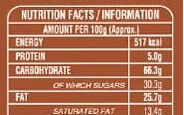Choose that food pack smartly

Can you think of a life without a pack of munchy-crunchy food pack besides our daily atta, dal, maida stuff? Well, no! But do you read the information well before buying any such product available on e-commerce sites or your nearby store shelves? If the answer is no, then we suggest you start inculcating the habit of reading your food pack labels before shelling out. You can zoom the image of a food pack and see how many calories are there in the food or know whether the organic product you are buying has been approved by food regulatory bodies or not. In this article, we have come up with a few tips that might help you to make healthier and smarter food choices.
Richa Pande
Packaged food items have additives in them for longer shelf life. Food additives are mandatorily declared in the ingredient list. Ingredients are listed in a specific pattern. The item which is mentioned first is usually the major ingredient used to prepare the food item, then the net ingredient and so on in descending order of the quantum used in the preparing of the product. Sometimes, the ingredients are even presented as percentage of content. You can base your choices by referring to the ingredient list and the quantum in the food item. It is always recommended that you go through the ingredient list
There are guidelines by food regulatory bodies on how much of these additives can be added to the food items, and food companies generally adhere to them. But you could cross the safety limits for any food additive by consuming excessive amounts of food items containing the same additive daily. It is to be noted that these safety limits are prescribed for adults and kids separately and hence excessive consumption of packaged foodstuffs should be avoided. Another reason why we need to be careful is that these packaged foods are generally high in sugar, fats, and added salt.


COOKIE 1
It has similar nutrient profile to that of COOKIE 2 but it has more food additives.

COOKIE 2
has similar nutrient profile to that of COOKIE 1 but it has lesser food additives.
INS numbers in the ingredient list
If you go through the ingredient list, you will notice INS numbers. Food additives have several colloquial names. To avoid confusion, universal numbers are allocated to different food additives. In Indian food packs, food additives are either referred to by their common names or by the universal INS numbers. In European Union countries, they are referred to as “E numbers”. Sometimes food manufacturers mention the contentious ingredient with a name which the consumer may be unaware of. Hence the consumer needs to be well informed to avoid being hoodwinked.
Checking the nutritional value of food products before making the purchase
Compare the variants and brands. Check the nutrition panel and compare the nutrition composition of the products. Prefer products that comply with the concept of clean labelling i.e., share complete information about a product. This will guide you in minding your portion sizes. After going through both the products, choose the products with the healthiest nutrition composition.


Plain Salt Chips Bag Brand 1 has lesser (by 2 g) saturated fats. Apart from this, it has almost a similar nutrient profile to that of Plain Salt Chips Bag Brand 2. Another thing to note is that brand 1 is also mentioning Sodium content and thus is supporting the concept of clean labelling.
Note that it is always recommended to mind the limit of saturated fats which is around 10-15 g per day. Therefore, pick a pack that has relatively lesser saturated fats and mind the portion sized to control the saturated fat intake.
Make a list of the items before you pick them
Always make a list of items you need before you decide to shop. This helps you in avoiding impulsive shopping. When you buy a product for the first time, read the ingredients list and nutrition table before purchasing the food item. Choose the food item only when you understand its label. It can help you not to make unnecessary purchases and in making healthier choices.
Check the existing front-of pack nutrition labels for quick comprehension
You might not find them in all the food packs in India but some global brands in the Indian market have started labelling nutrients on the front of the pack. From these food packs, one can get an understanding about the apt portion/serving size and calories in one portion/serving item. In some packs, you might also get information about other nutrients of concern like fat, sugar, sodium, and calories.


Choose smaller packs over the large packs for individual consumption
The smaller packets contain fewer calories as compared to the large ones. A 30g chips packet has 150 calories, while a 50g package has 250 calories. Always look for the recommended portion size on the pack.
Choosing food items using food certification and quality symbols- You can look for these food quality and certification marks on your food items to make healthy choices
- AGMARK is a certification mark by the Ministry of Agricultural & Farmers Welfare, Government of India. The present AGMARK standards cover quality guidelines for 224 different commodities spanning a variety of pulses, cereals, essential oils, vegetable oils, fruits and vegetables and semi-processed products like macaroni and vermicelli.

- You will find either one of them on the food packs. Green logo certifies that the product does not contain non-plant-based ingredients or by-products. Previously the triangular red logo was also represented by a circle. The step to change it to a triangle shape was taken to help the colour-blind people

- ISI (Indian Standards Institution) mark is a certification label-mark for industrial products in India. It is the most popular and recognised certification mark.

- FSSAI stands for Food Standards and Safety Authority of India, which is the food regulatory body in India that deals with the food safety issues. This logo on the supplement means that the product’s manufacturing process has received certification from FSSAI.

- ECOCERT was introduced in the year 1991. It is a certification given to those products that conform to a set of standards aimed at the least impact on the ecosystem. it serves as an advisory to consumers.

- FPO (Farmer Producer Organization) a mandatory mark that one will find on all processed fruit products sold in India such as packaged fruit beverages, fruit-jams, crushes and squashes, pickles, dehydrated fruit products, and fruit extracts following the Food Safety and Standards Act of 2006

- Indocert is a government accredited certification authority in India which operates at both national and international level. It provides certifications for sustainable agricultural standards

- Gluten is a protein found in wheat and other cereals like barley and rye. Some people have gluten intolerance, which means that they cannot digest it and might encounter allergy like symptoms when they consume it. Presence of this logo ensures that the ingredients in the supplement are gluten-free
- This logo enables people to identify that a certain food is fortified with a micronutrient.

- Fair Trad logo- Look for this logo to pick a food item that has been grown and prepared following fair-trade practices.
Organic Food Logos
- Jaivik Bharat Logo -It is a logo issued by Indian government authorities to the products which are grown organically as per the standards set by NPOP, India and PGS-India

- USDA Organic Logo-This logo ensures that all the ingredients used in the development of this supplement are 95 per cent or more organic in nature. This means that they are free of chemical additives, pesticides, chemical fertilizers, and colors. The certification is provided by United States Department of Agriculture

- India Organic Logo -Presence of this certification mark on the label of a supplement ensures that the ingredients in the products were grown organically and they comply with the standards set by National Standards for Organic Production (NSOP)

- EU Organic Logo-This logo on the label of a supplement ensures that the food supplement is made conforming to the organic food production guidelines set by the European Union

Food packets have a lot of information on them. It is important that we go through it when we are purchasing a food item for the first time. Making this a habit can help us making healthier food choices in a long run.
Related
Decoding Cyber Coverage in India: Your Ultimate Guide
In today's technology-driven landscape where digitalization is ubiquitous, companies confront an escalating threat landscape in the form of...
Navigating Insurance Options: Comprehensive Coverage for Diabetics in India
As the prevalence of diabetes continues to rise steadily in India, individuals grappling with this chronic condition encounter myriad challenges,...
Understanding International Travel Insurance
International travel insurance serves as a financial product crafted to shield travellers from unforeseen events and expenses while journeying...


